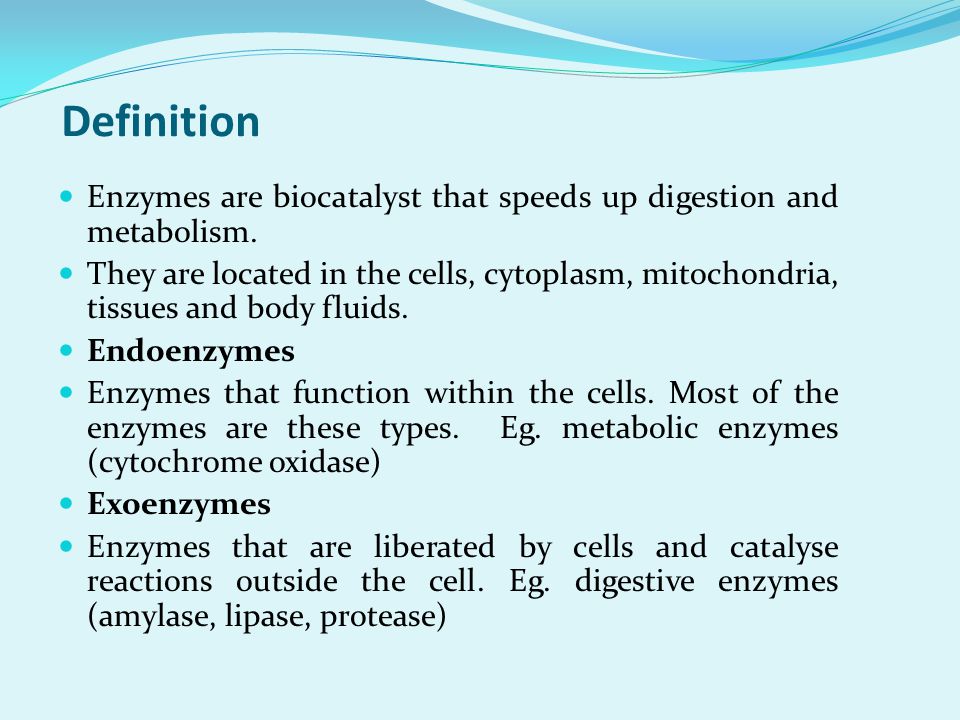Enzymes definition easy

Enzymes Definition Classification Chemical Properties
Mechanism of enzymatic action
Factors Affecting Enzyme Activity
2 Definition
Enzymes are biocatalysts that speed up digestion and metabolism.
They are found in cells, cytoplasm, mitochondria, tissues, and body fluids.
Endoenzymes
Enzymes that work inside cells. Most enzymes are of this type. E.g. metabolic enzymes (cytochrome oxidase)
Exoenzymes
Enzymes that are released by cells and catalyze reactions outside the cell. E.g. digestive enzymes (amylase, lipase, protease)
3 classification
Enzymes are named based on substrate, reaction, synthesis, chemical nature
Based on the substrate:
Enzymes are named by adding the suffix ase to the name of the substrate
Carbohydrates carbohydrates
Protein proteinase
Lipid lipases
Nucleic acid nucleases
Maltose maltase
Lactose lactase
Sucrose sucrase
Urease urease
4 According to the Enzyme Commission of the International Union of Biochemistry, enzymes are classified into six main classes.
Catalyzed class reactions
Oxidoreductoases Oxidation-reduction
Transferase group of transfer atoms
Hydrolysis of hydrolases
Lyases Add / remove atoms to / from a
double bond
Isomerases rearrange atoms
Ligaases Combine molecules using
ATP
5 Chemistry of enzymes
Enzymes are large specialized protein molecules made up of one or more polypeptide chains.
Enzymes can be composed solely of proteins or a combination of proteins and non-protein parts.
Simple enzymes composed solely of proteins.
The holoenzymes / conjugates comprise a protein and a non-protein part.
Protein component - apoenzyme
Non-protein part - cofactor
Prosthetic group - cofactor firmly attached to
enzyme
Coenzyme: cofactor loosely bound to the enzyme
6 Properties of Protein Enzymes
Accelerate the chemical reaction without undergoing changes.
Specific in action
Required in small quantity
Suffers denaturation
Reversibility of enzyme action
7 Mechanism of enzymatic action
Michaelis and Menton proposed a hypothesis for the action of enzymes.
According to your hypothesis, the following steps are taken:
1. enzyme-substrate combination
-substrate adheres to the enzyme's active site to form the enzyme-substrate complex.
2. Breakdown of the substrate
-Active site loosens chemical bonds in the substrate by breaking down the substrate into products.
8 3. Enzyme Dissociation - The enzyme eventually dissociates from the final products and is free to combine another substrate molecule.
9 Enzyme-substrate complex formation
Two hypotheses
1. Lock and key hypothesis
2. induced fit hypothesis
10 Lock and key hypothesis
Proposed by Emil Fisher (1914)
According to this hypothesis, the active sites of the enzyme are rigid with the appropriate conformation.
The substrate simply snaps into the active site to form a reaction intermediate.
11 Induced fit hypothesis
Proposed by Khosland (1963)
According to this hypothesis, active sites are flexible.
The enzyme molecule changes shape as the substrate molecules get closer together.
The substrate changes the conformation of the enzyme's active site that closely matches it.
12 Induced fit hypothesis
13 factors that affect enzyme activity
The activity of the enzyme is affected by several factors.
Temperature
Enzyme activity increases with increasing temperature up to 40 ° C.
Most of the enzyme optimal temperature
